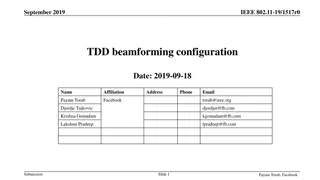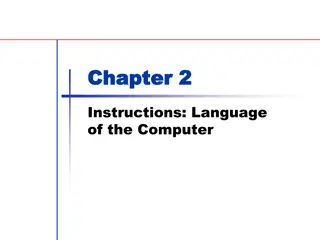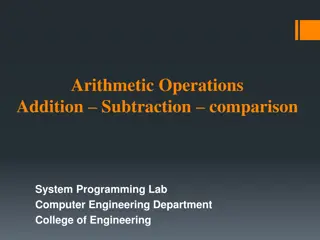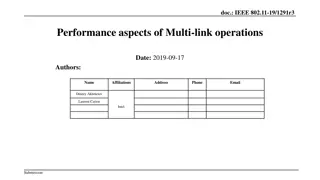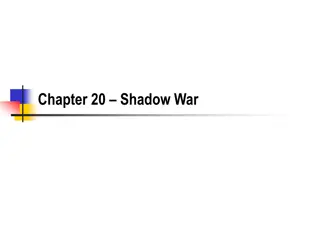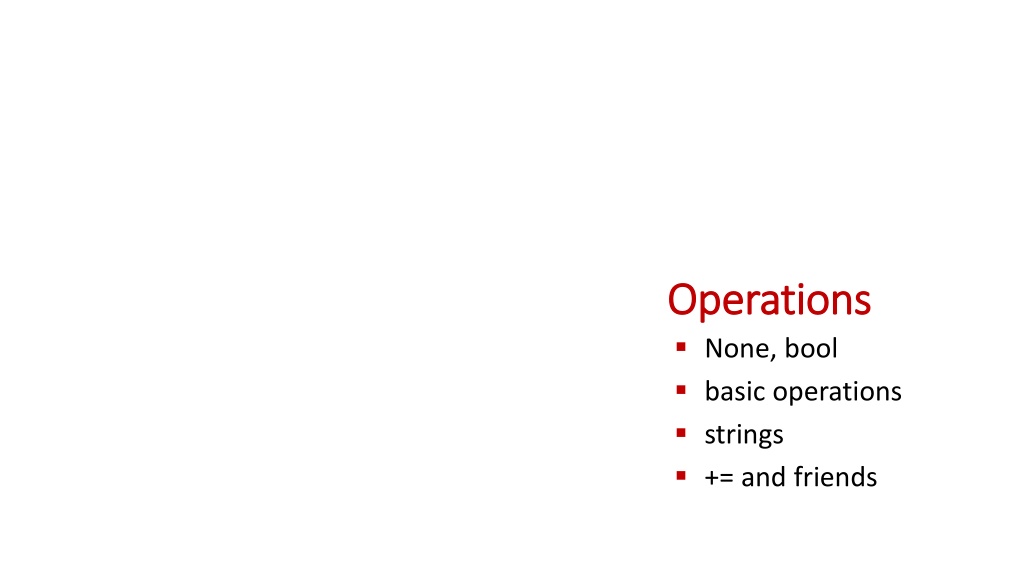
Understanding Basic Operations and Types in Python
Explore the fundamental concepts of operations in Python, including NoneType, boolean values, scalar vs non-scalar types, and integer and float operations. Learn about relevant examples and best practices for using these foundational concepts in Python programming.
Download Presentation

Please find below an Image/Link to download the presentation.
The content on the website is provided AS IS for your information and personal use only. It may not be sold, licensed, or shared on other websites without obtaining consent from the author. If you encounter any issues during the download, it is possible that the publisher has removed the file from their server.
You are allowed to download the files provided on this website for personal or commercial use, subject to the condition that they are used lawfully. All files are the property of their respective owners.
The content on the website is provided AS IS for your information and personal use only. It may not be sold, licensed, or shared on other websites without obtaining consent from the author.
E N D
Presentation Transcript
Operations Operations None, bool basic operations strings += and friends
NoneType NoneType The type None has only one value: None Used when context requires a value, but none is really available Example: All functions must return a value. The function print has the side-effect of printing something to the standard output, but returns None Python shell > x = print(42) | 42 > print(x) | None Example: Initialize a variable with no value, e.g. list entries mylist = [None, None, None]
Named after mathematician George Boole (1815-1864) Type bool Type bool The type bool only has two values: True and False Logic truth tables: x or y True True True False True x and y True True True False False x not x False True False True False False False False False True
Scalar vs Non Scalar vs Non- -scalar Types scalar Types Scalar types (atomic/indivisible): int, float, bool, None Non-scalar: Examples strings and lists "string"[3] = "i" [2, 5, 6, 7][2] = 6
Questions Questions What is What is [7,3,5][[1,2,3][1]] ? ? a) 1 b) 2 c) 3 d) 5 e) 7 f) Don t know
Operations on Operations on int int and float and float Result is float if and only if at least one argument is float, except ** with negative exponent always gives a float +, -, * addition multiplication, e.g. 3.0*2 = 6.0 ** and pow(x, y) power, e.g. 2**3=pow(2,3)=8, 2**-2=0.25 // integer division = x / y e.g. 15.0//4= 3.0. Note: -8//3=-3 / division returns float, 6/3=2.0 abs(x) absolute value % integer division remainder (modulo) 11%3 =2 4.7%0.6=0.5000000000000003 Python shell > 0.4 // 0.1 | 4.0 > 0.4 / 0.1 | 4.0 > 0.3 // 0.1 | 2.0 > 0.3 / 0.1 | 2.9999999999999996 > 10**1000 / 2 | OverflowError: integer division result too large for a float
Running time for 3 ** x // 3 ** x Running time for 3 ** x // 3 ** x Working with larger integers takes slightly more than linear time in the number of digits
integer-division-timing.py from time import time import matplotlib.pyplot as plt bits, compute_time = [], [] for i in range(42): x = 3 ** i // 2 ** i start = time() result = 3 ** x // 3 ** x # the computation we time end = time() t = end - start print('i =', i, 'x =', x, 'Result =', result, 'time(sec) =', t) bits.append(x) compute_time.append(t) plt.title('Computing 3**x // 3**x') plt.xlabel('x') plt.ylabel('computation time (seconds)') plt.plot(bits, compute_time, 'g:') plt.plot(bits, compute_time, 'ro') plt.show()
module math module math Many standard mathematical functions are available in the Python module math , e.g. sqrt, sin, cos, tan, asin, acos, atan, log(natural), log10, exp, ceil, floor, ... To use all the functions from the math module use import math Functions are now available as e.g. math.sqrt(10) and math.ceil(7.2) To import selected functions you instead write from math import sqrt, ceil The library also contains some constants, e.g. math.pi = 3.141592... and math.e = 2.718281... Note: x ** 0.5 significantly faster than sqrt(x) Python shell > (0.1 + 0.2) * 10 | 3.0000000000000004 > math.ceil((0.1 + 0.2) * 10) | 4 docs.python.org/3/library/math.html module statistics contains basic functions like mean and variance, see docs.python.org/3/library/statistics.html
Python shell > import math > math.sqrt(8) | 2.8284271247461903 > from math import pi, sqrt > pi | 3.141592653589793 > sqrt(5) | 2.23606797749979 > from math import sqrt as kvadratrod > kvadratrod(3) | 1.7320508075688772 > import timeit > timeit.timeit("1e10**0.5") | 0.021124736888936863 > timeit.timeit("sqrt(1e10)", "from math import sqrt") | 0.1366314052865789 > timeit.timeit("math.sqrt(1e10)", "import math") | 0.1946660841634582 docs.python.org/3.12/library/timeit.html
Rounding up Rounding up integer fractions integer fractions Python shell > from math import ceil > from timeit import timeit > 13 / 3 | 4.333333333333333 > 13 // 3 | 4 > -13 // 3 | -5 > -(-13 // 3) | 5 > ceil(13 / 3) | 5 > -(-22222222222222222223 // 2) | 11111111111111111112 > ceil(22222222222222222223 / 2) | 11111111111111110656 > timeit('ceil(13 / 3)', 'from math import ceil') | 0.2774667127609973 > timeit('-(-13 // 3)') # negation trick is fast | 0.05231945830200857 Python: x/y = -(-x//y) -(-13/3) Python Java C -(-13//3) = 5 -(-13/3) = 4 -(-13/3) = 4 The intermediate result x/y in math.ceil(x/y) is a float with limited precision Alternative computation: x/y = (x+(y-1))//y
floats : Overflow, floats : Overflow, inf inf, , - -inf inf, nan , nan Python shell > 1e250 ** 2 | OverflowError: (34, 'Result too large') > 1e250 * 1e250 | inf > -1e250 * 1e250 | -inf > import math > math.inf | inf > type(math.inf) | <class 'float'> > math.inf / math.inf | nan > type(math.nan) | <class 'float'> > math.nan == math.nan | False > float('inf') - float('inf') | nan There exists special float values inf, -inf, nan representing +infinity , -infinity and not a number Can be created using e.g. float('inf') or imported from the math module Some overflow operations generate an OverflowError, other return inf and allow calculations to continue ! Read the IEEE 754 standard if you want to know more details...
Operations on bool Operations on bool The operations and, or, and not behave as expected when the arguments are False/True. The three operators also accept other types, where the following values are considered false: False, None, 0, 0.0, "", [] (see The Python Standard Library > Built-in Types > True Value Testing for more false values) Short-circuit evaluation: The rightmost argument of and and or is only evaluated if the result cannot be determined from the leftmost argument alone. The result is either the leftmost or rightmost argument (see truth tables), i.e. the result is not necessarily False/True. True or 7/0 is completely valid since 7/0 will never be evaluated (which otherwise would throw a ZeroDivisionError exception) x x or y y x x x and y x y x not x True False false false false otherwise otherwise otherwise
Questions Questions What is What is "abc" and 42 ? ? a) False b) True c) "abc" d) 42 e) TypeError f) Don t know
Comparison operators (e.g. Comparison operators (e.g. int int, float, , float, str str) ) Python shell > 3 == 7 | False > 3 == 3.0 | True > "-1" != -1 | True > "abc" == "ab" + "c" | True > 2 <= 5 | True > -5 > 5 | False > 1 == 1.0 | True > 1 == 1.0000000000000001 | True > 1 == 1.000000000000001 | False == test if two objects are equal, returns bool not to be confused with the assignment operator (=) != not equal > >= < <=
Chained comparisons Chained comparisons A recurring condition is often x < y and y < z If y is a more complex expression, we would like to avoid computing y twice, i.e. we often would write tmp = complex expression x < tmp and tmp < z In Python this can be written as a chained comparisons (which is shorthand for the above) x < y < z Note: Chained comparisons do not exist in C, C++, Java, ...
Questions Questions What is What is 1 < 0 < 6/0 ? ? a) True b) False c) 0 d) 1 e) 6 f) ZeroDivisionError g) Don t know
Binary numbers and operations Binary numbers and operations Binary number = integer written in base 2: 1010102= 4210 = 21+ 23+25 Python constant prefix 0b: 0b101010 42 bin(x) converts integer to string: bin(49) "0b110001" int(x, 2) converts binary string value to integer: int("0b110001", 2) 49 Bitwise operations | Bitwise OR & Bitwise AND ~ Bitwise NOT (~ x equals to x - 1) ^ Bitwise XOR Example: bin(0b1010 | 0b1100) "0b1110" Hexadecimal = base 16, Python prefix 0x: 0x30 48, 0xA0 160, 0xFF 255 << and >> integer bit shifting left and right, e.g. 12 >> 2 3, and 1 << 4 16
Python shell Operations on strings Operations on strings len(str) returns length of str str[index] returns index+1 th symbol in str str1+ str2 returns concatenation of two strings int * str concatenates str with itself int times Formatting: % operator or .format() function old Python 2 way > len("abcde") | 5 > "abcde"[2] | 'c' > x, y = 2, 3 > "x = %s, y = %s" % (x, y) | 'x = 2, y = 3' > "x = {}, y = {}".format(x, y) | 'x = 2, y = 3' > "x = {1}, y = {0}".format(y, x) | 'x = 2, y = 3' > f'x + y = {x + y}' | 'x + y = 5' > f'{x + y = }' # >= Python 3.8 | 'x + y = 5' > f'{x} / {y} = {x / y:.3}' | '2 / 3 = 0.667' > "abc" + "def" | 'abcdef' > 3 * "x--" | 'x--x--x--' > 0 * "abc" | '' since Python 3.0 or formatted string literals (f-strings) with prefix since Python 3.6 letter f and Python expressions in {} (see pyformat.info for an introduction) From What s New In Python 3.0 , 2009: A new system for built-in string formatting operations replaces the % string formatting operator. (However, the % operator is still supported; it will be deprecated in Python 3.1 and removed from the language at some later time.) Read PEP 3101 for the full scoop. % formatting (inherited from C s sprint() function) was supposed to be on the way out - but is still going strong in Python 3.12
Python Python does does not not automatic automatic convert convert to to string string A str can not be concatenated with an int The int must first be converted to a str using str(int value) Python shell works in Java and Javascript > 'abc' + 42 | TypeError: can only concatenate str (not "int") to str > 'abc' + str(42) | 'abc42' In some languages, like Java and Javascript, the conversion to string happens automatically (just a language design choice)
... more string functions ... more string functions str[-index] returns the symbol i positions from the right, the rightmost str[-1] str[from:to] substring starting at index from and ending at index to-1 str[from:-to] substring starting at form and last at index len(str)- to -1 str[from:to:step] only take every step th symbol in str[from:to] from or/and to can be omitted and defaults to the beginning/end of string chr(x) returns a string of length 1 containing the x th Unicode character ord(str) for a string of length 1, returns the Unicode number of the symbol str.lower() returns string in lower case str.split() split string into list of words, e.g. "we love python".split() = ['we', 'love', 'python'] docs.python.org/3/library/string.html
Python shell > s = 'this is a string' > s.capitalize() | 'This is a string' > s.title() | 'This Is A String' > s.upper() | 'THIS IS A STRING' > s.title().swapcase() | 'tHIS iS a sTRING > s.removeprefix('this is ') | 'a string' > s.removesuffix(' string') | 'this is a' > s.replace('is', 'IS') | 'thIS IS a string' > s.ljust(30) | 'this is a string ' > s.center(30) | ' this is a string ' > s.rjust(30, '.') | '..............this is a string' > s.count('i') | 3 > '12345'.zfill(8) | '00012345' https://docs.python.org/3/library/stdtypes.html#text-sequence-type-str
Questions Questions What is What is s[2:42:3]? ? 0 1 2 3 4 5 6 7 8 9 10 11 12 13 14 15 16 17 18 19 20 21 22 23 24 25 26 27 28 29 30 31 32 33 34 35 36 37 38 39 40 41 42 43 44 s = 'abwwdexy___lwtopavghevt_xypxxyattx_hxwoadnxxx' a) 'wwdexy___lwtopavghevt_xypxxyattx_hxwoadn' b) 'we_love_python' c) 'we_love_java' d) Don t know
Strings are immutable Strings are immutable Strings are non-scalar, i.e. for s = "abcdef", s[3] will return "d" Strings are immutable and cannot be changed once created. I.e. the following natural update is not possible (but is e.g. allowed in C) s[3] = "x" To replace the "d" with "x" in s, instead create the new string s = s[:3] + "x" + s[4:]
Precedence (low to high) or and not x in is is not == < <= != > | ^ & << >> + - * @ / // % +x -x ~x ** Operators Operators Precedence rules & Associativity Precedence rules & Associativity Example: * has higher precedence than + not in 2 + 3 * 4 2 + (3 * 4) 14 and (2 + 3) * 4 20 >= All operators in same group are evaluated left-to-right 2 + 3 - 4 - 5 ((2 + 3) - 4) - 5 -4 except for **, that is evaluated right-to-left 2**2**3 2**(2**3) 256 Rule: Use parenthesis whenever in doubt of precedence! docs.python.org/3/reference/expressions.html
Long expressions Long expressions Long expressions can be broken over several lines by putting parenthesis around it Python shell > (1 + 2 + The PEP8 guidelines recommend to limit all lines to a maximum of 79 characters 3) | 6 https://www.python.org/dev/peps/pep-0008/#maximum-line-length
+= and friends += and friends Recurring statement is x = x + value In Python (and many other languages) this can be written as x += value Python shell > x = 5 > x *= 3 > x | 15 > a = 'abc' > a *= 3 > a | 'abcabcabc' This also applies to other operators like += -= *= /= //= **= |= &= ^= <<= >>=
:= a := assignment expressions ssignment expressions (the Walrus Operator ) (the Walrus Operator ) Syntax Python shell > (x := 2 * 3) + 2 * x | 18 > print(1 + (x := 2 * 3), 2 + x) | 7 8 > x := 7 | SyntaxError > (x := 7) # valid, but not recommended > while line := input(): print(line.upper()) > abc | ABC name := expression Evaluates to the value of expression, with the side effect of assigning result to name Useful for naming intermediate results/repeating subexpressions for later reusage See PEP 572 for further details and restrictions of usage In some languages, e.g. Java, C and C++, = also plays the role of := , implying if (x=y) and if (x==y) mean quite different things (common typo)









